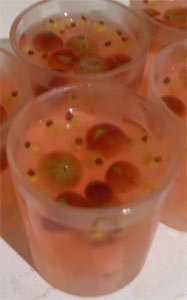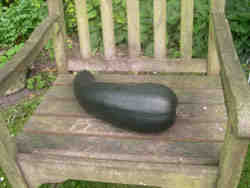Dessert gooseberry and white currant jellies recipe
Posted by Fiona Nevile in Desserts | 14 comments Sometimes we both cook when friends come for supper. If Danny is doing the main course he’s not keen on sharing a stove ever since the time I cooked my starters in the top oven and the kitchen filled with black noxious smoke. We’d only used this part of the oven as a grill before. And since.
Sometimes we both cook when friends come for supper. If Danny is doing the main course he’s not keen on sharing a stove ever since the time I cooked my starters in the top oven and the kitchen filled with black noxious smoke. We’d only used this part of the oven as a grill before. And since.
Now I generally make the starter and the pud in the morning. Jellies are ideal if you are preparing in advance. They are easy, look pretty and are a great way of padding out a small tray of soft fruit.
Even though I’m now Queen of the Fruit Cages I have plans for this fruit – most will star in epics on the drinks tray.
Under the nets this week, happily chatting to a neighbour who was cutting back one of our shrubs that had quietly infiltrated his garden, I realised why soft fruit is so expensive. It takes ages to pick. The temptation to eat as one picks doesn’t help. It’s important to savour some as soft fruit is at its best guzzled immediately but this can be dangerous if one is pressed for time. As I listened to my nieghbour’s stories, from the shade of the raspberry canes, time drifted. Hearing his tales of working on an old English estate had me at the fence in a second, raspberries forgotten.
“When her ladyship died we had two days to get the lowering of the coffin into the grave right.
They said,
‘Smith, dig a deep trench.’
And that done we practiced lowering an old oak gate post into the depths. On ribbons mind you! If the coffin doesn’t go down straight and square it can roll and has been known to open.”
He peered at me steadily, through the brambles.
My neighbour turned down the offer of a handfull of plump raspberries.
“Sorry Fiona, I’m not a soft fruit man but I am keeping the blackberry canes that have scrambled over from yours. The berries were nice and pump last year and made a good blackberry and apple crumble.”
So I moved out of earshot, into the other cage where I’m cosseting loads of other fruit. One hero is a dessert gooseberry bush. These blush when ripe and can be eaten without sugar. They have a similar tartness to a kiwi fruit. A great investment if you ever see a bush for sale. They are definitely worth the extra expense as they are far more useful than the standard gooseberry. They can be cooked but are great raw in fresh fruit salads and they’re perfect for jellies and garnishes. Unfortunately they are not as prolific as an ordinary gooseberry bush. Our bush made six individual jellies and will provide the voompf for a 75mll bottle of dessert gooseberry vodka. So it is treated with respect.
A white currants bush also lurks in this cage. Not as bountiful as redcurrants and miles behind the harvest one can pick from a blackcurrant bush. However, if you have the space a white currant bush is a great investment. Pretty white berries, almost sweet enough to eat straight from the bush. They have a palatable tartness that bursts softy in the mouth. Again perfect for jellies and possibly for white currant vodka. The Cottage Smallholder Fruit Gin and Vodka Research Station is going to try this for the first time this year. It will be secreted in a safe spot in the barn and opened at Christmas.
| Dessert gooseberry and white currant jellies recipe |
- 500ml of water
- 75g of vanilla castor sugar (we keep a vanilla pod in our jar)
- 1 tsp of fresh lemon juice
- 100g of dessert gooseberries
- 50g of white currants
- 2 tsp of kirsch
- 4 leaves of gelatine
- Wash, top and tail the gooseberries. Reserve 25g of gooseberries and slice these to add to the jelly in the final stages. Wash the white currants and remove the fruit from the stalks. If you have infinite patience you can snip the dark ends from the fruit. They taste fine with dark ends in place.
- Dissolve the sugar in the water, add 75g of gooseberries and bring slowly up to simmering point. Simmer the gooseberries for 5 minutes and then remove from the heat and steep for five minutes. Strain the mixture through muslin and reserve the liquid.
- Meanwhile soak the gelatine in cold water until soft. Squeeze out the water gently and add the gelatine to the (hot not boiling) gooseberry liquid and stir to dissolve. Add the kirsch.
- Allow the jelly mixture to cool before dividing the remaining gooseberries and the white currants between 6-8 100ml glasses.
- Pour the jelly mixture into each glass, over the fruit and allow to set (this can take several hours). Transfer the jellies to the fridge when they are cool enough. Refrigerated, these jellies will keep for a couple of days.
Leave a reply






Hi Sam
Tou can’t beat a good, grown up jelly!
OK
I’ve been playing with Jelly recipies thanks to you and wow!!!!!!!!!!!!!! I’ve found some good ones.
Sam
Hi Helena
Of course it’s rescuable. Use the same ammount of sugar as in the raspberry gin recipe initially and tweek after a couple of months.
Great that you’re enjoying the site!
Hello fn – long time lurker fan, first time poster.
I absolutely love your site and have been in a frenzy of activity down at the local PYO farm, having got the liqueur-making bit firmly between my teeth this year.
However, I’ve just realised that, in my enthusuasm, I’ve rushed out and laid down some gooseberry vodka with green gooseberries (instead of being patient and waiting for the reddish dessert ones).
Total disaster do you think – or rescue-able with more sugar?